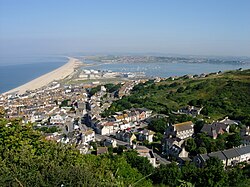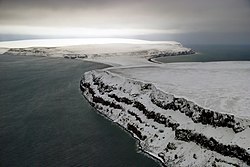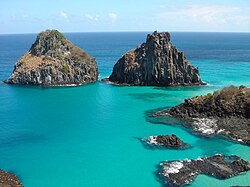

A tombolo is a sandy or shingle isthmus. It is a deposition landform by which an island becomes attached to the mainland by a narrow piece of land such as a spit or bar. [1] Once attached, the island is then known as a tied island. The word tombolo is from the Italian tombolo, meaning 'pillow' or 'cushion', and sometimes translated incorrectly as ayre (an ayre is a shingle beach of any kind).
Contents
- Formation
- Wave diffraction and refraction
- Unidirectional longshore drift
- Morphology and sediment distribution
- Examples
- Image gallery
- See also
- References
- External links
Several islands tied together by bars which rise above the water level are called a tombolo cluster. [2] Two or more tombolos may form an enclosure (called a lagoon) that can eventually fill with sediment.










